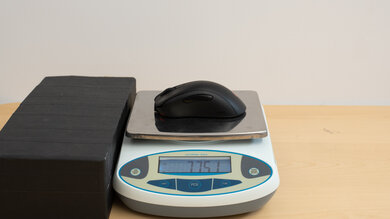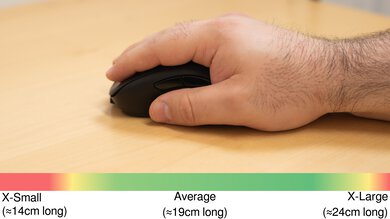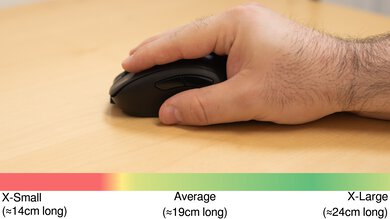The BenQ ZOWIE EC2-CW is a wireless gaming mouse that continues the BenQ ZOWIE's EC lineup. This mouse is the Medium-size option in the EC-CW Series, and along with its Small and Large-size variants, they're the first wireless mice BenQ ZOWIE have released. Like other mice in BenQ ZOWIE's catalog, this mouse is aimed mainly at competitive gamers and esports. This mouse is driverless, and its plug-and-play design means it has no customization software, but you can change sensor settings directly on the mouse itself. This mouse also includes what BenQ ZOWIE refer to as an Enhanced Receiver station, which acts as a charging dock and which they claim also provides better signal stability in congested wireless environments.
Our Verdict
Although not designed specifically for this use, the BenQ ZOWIE EC2-CW is okay for office work. It has excellent build quality and a comfortable ergonomic shape suitable for most hand sizes. However, this mouse lacks Bluetooth support and can't pair with multiple devices simultaneously. Also, there isn't any customization software for reprogramming buttons, and the scroll wheel lacks L/R tilt inputs and a free-scrolling mode.
-
Excellent build quality.
-
Scroll wheel lacks L/R tilt inputs and a free-scrolling mode.
-
No customization software.
The BenQ ZOWIE EC2-CW is an excellent FPS gaming mouse with a comfortable ergonomic shape suitable for most hand sizes. It has low click latency and outstanding all-around sensor performance. It's considerably heavier than many other FPS-focused mice, so it isn't as easy to move quickly and accurately. Furthermore, its stock feet also don't glide as smoothly as those on similarly priced gaming mice.
-
Excellent click latency.
-
Excellent build quality.
-
Exceptional sensor accuracy.
-
Amazing sensor latency.
-
Stock mouse feet don't glide as smoothly as those on most other gaming mice at this price point.
-
Heavier than many other dedicated FPS gaming mice.
The BenQ ZOWIE EC2-CW is okay for MMO gaming, but it doesn't have nearly as many side buttons as a dedicated MMO gaming mouse. It has excellent build quality and a comfortable ergonomic shape suitable for most hand sizes. It also has excellent click latency and all-around sensor performance, delivering a consistent and responsive in-game experience.
-
Excellent build quality.
-
Exceptional sensor accuracy.
-
Amazing sensor latency.
-
Not nearly as many side buttons as a dedicated MMO gaming mouse.
-
Stock mouse feet don't glide as smoothly as those on most other gaming mice at this price point.
The BenQ ZOWIE EC2-CW has outstanding performance overall. Its sensor provides amazing movement latency and exceptional accuracy that closely translates your physical mouse movements with those you see on-screen. It also has very low click latency, providing a snappy and responsive-feeling gaming experience. However, the click latency isn't as low as other wireless options around this price point.
-
Excellent click latency.
-
Exceptional sensor accuracy.
-
Amazing sensor latency.
- 6.5 Work
- 8.4 Video Games (FPS)
- 6.5 Video Games (MMO)
- 9.2 Raw Performance
Changelog
-
Updated Jun 19, 2025:
We've added a link to the newly reviewed successor to this mouse, the BenQ ZOWIE EC2-DW, in the Weight section.
- Updated Aug 15, 2024: We've added a link to the newly-reviewed Vaxee ZYGEN NP-01S Wireless (4K) in the Hand Size Recommendation section.
- Updated Jul 18, 2024: We've added a link to the GLORIOUS Model D 2 Wireless in the Wireless Versatility section of this review.
- Updated Mar 28, 2024: We've added a link to the newly-reviewed BenQ ZOWIE U2 in the Hand Size Recommendation section of this review.
- Updated Feb 21, 2024: We've added a link to the newly-reviewed Pulsar Xlite V3 in the Weight section of this review.
Check Price
Differences Between Sizes And Variants
The BenQ ZOWIE EC2-CW is only available in a black colorway. This mouse is part of a wider lineup of EC-CW Series, which are wireless versions of BenQ Zowie's original EC Series mice. There are three different size variants available for this mouse.
| Name | Size |
| EC3-CW | Small |
| EC2-CW | Medium |
| EC1-CW | Large |
We bought and tested the Medium-sized EC2-CW, but we expect the results of our tests to broadly apply to all three size variants. You can see the label of the unit we bought and tested here.
Compared To Other Mice
The BenQ ZOWIE EC2-CW is the Medium-size variant in the EC-CW Series, and along with its Small and Large-size variants, they are the first wireless mice BenQ ZOWIE has released. This mouse is advertised for Esports players. Unlike many gaming mice, they don't have customization software which is typically not allowed for tournament play—instead, you can change settings on the mouse itself. This mouse also includes what BenQ ZOWIE calls an Enhanced Receiver, which they claim provides better wireless stability, especially in environments with lots of wireless signal interference, like LAN events or competitions. However, compared to other flagship gaming mice at this price point, like the Razer DeathAdder V3 Pro or Logitech G PRO X SUPERLIGHT, the BenQ ZOWIE isn't pushing the same technological boundaries as it's significantly heavier and doesn't perform as well.
For more recommendations, see our picks for the best mouse, the best gaming mouse, and the best wireless gaming mouse.
The BenQ ZOWIE EC2-DW is the successor to the BenQ ZOWIE EC2-CW. While keeping the same shape, the DW improves on the CW with some small, yet meaningful changes that add up for a better overall experience. Namely, it's significantly lighter, has better mouse feet, and has a new sensor with a higher maximum polling rate of 4000Hz.
The Razer DeathAdder V3 Pro and the BenQ ZOWIE EC3-C are wireless gaming mice with similar right-handed shapes. The Razer is significantly lighter and performs somewhat better. It also has higher-quality feet and has software for adjusting settings. On the other hand, the BenQ doesn't have software but allows you to customize settings directly on the mouse itself.
The BenQ EC2-CW and the Logitech G PRO X SUPERLIGHT are wireless gaming mice. The BenQ has a right-handed shape and doesn't have customization software. However, you can change sensor settings on the mouse itself. On the other hand, the Logitech has a symmetrical shape and has software for customization. It's also significantly lighter and performs better overall. Additionally, it has higher-quality feet and feels a bit sturdier.
The BenQ ZOWIE EC3-C and the BenQ ZOWIE EC2-CW are related gaming mice within the wider BenQ ZOWIE EC lineup. Both mice have the same basic shape but have different size variants. The EC3-C is a wired-only model and a Large size variant within the series. On the other hand, the EC2-CW is a wireless model and a Medium-size variant.
The Pulsar Xlite V3 is a better wireless gaming mouse than the BenQ ZOWIE EC2-CW. The two have similar right-handed shapes, but the Pulsar is significantly lighter. The Pulsar has better performance, too, with lower click latency, better mouse feet, and a lower minimum lift-off distance.
The BenQ ZOWIE EC2-CW and the BenQ ZOWIE U2 are models in BenQ ZOWIE's broader ecosystem of wireless gaming mice. These mice share the same design approach and internal components; the only major difference is their shape. The EC2-CW has a right-handed 'ergo' shape and is best suited for palm or claw grip types. On the other hand, the U2 has more narrow sides and is designed specifically for claw grip.
The ASUS ROG Harpe Ace Aim Lab Edition and the BenQ ZOWIE EC2-C are wireless gaming mice. The ASUS has a symmetrical shape, is significantly lighter, and performs better overall. It also has higher-quality feet, supports Bluetooth, and has software for adjusting settings. On the other hand, the BenQ has a right-handed shape. It doesn't have customization software but allows you to adjust settings directly on the mouse itself.
The BenQ ZOWIE EC2-CW and the Pwnage StormBreaker are wireless gaming mice with very similar shapes. The BenQ has a solid plastic body. On the other hand, the Pwnage has a magnesium alloy body with weight-saving cutouts. It's significantly lighter and has better overall gaming performance. It also supports a higher wireless polling rate of 4000Hz and has an unusual feature that allows you to adjust the sensor position.
Test Results
The body of this mouse is made of matte black plastic, and the two side buttons on the left are made of glossy black plastic. There's a red ZOWIE logo on the bottom of the palm area and a reflective BenQ logo on the left side towards the rear. There aren't any RGB lighting zones, but a small set of LEDs below the scroll wheel and between the left- and right-click buttons show the current battery level.
The BenQ ZOWIE EC2-CW has the same ergonomic, right-handed shape as the previous-generation BenQ ZOWIE EC2.
The EC2-CW is a Medium size variant in BenQ ZOWIE's lineup of wireless EC-CW mice. There is also a Large size variant called the BenQ ZOWIE EC1-CW and a Small variant called the BenQ ZOWIE EC3-CW. You can see images of the dimensions of these variants on BenQ ZOWIE's website here.
The BenQ ZOWIE EC2-CW has excellent build quality. It feels very solid in hand, and there's no creaking or flexibility on the top or sides. That said, the bottom plate is somewhat flexible, and you can actuate the right-click button by applying enough pressure to the underside, but this doesn't present any issues when using the mouse normally.
The BenQ ZOWIE EC2-CW is somewhat lightweight and reasonably easy to move quickly and accurately. However, it's heavier than many other dedicated FPS gaming mice at this price range. If you want a lighter mouse with a similar right-handed shape, check out the Pulsar Xlite V3.
The BenQ ZOWIE EC2-DW is the successor to this mouse, and is significantly lighter while keeping the same shape and feature set.
The BenQ ZOWIE EC1-C has a very comfortable right-handed shape with a full, rounded hump towards the middle. This mouse is a good fit for medium and larger-sized hands and is best suited for a palm or claw grip.
This mouse is the Medium variant in a lineup that also features a Large and Small size. If you have smaller hands, you may prefer the smaller-sized BenQ ZOWIE EC3-CW, or if you have extra-large hands, you'll be more comfortable using the BenQ ZOWIE EC1-CW. If you'd prefer another option in BenQ ZOWIE's wireless ecosystem with a symmetrical shape and narrower sides, check out the review for the BenQ ZOWIE U2. Or, for an alternative with a slightly smaller shape, flatter top, and less pronounced rear hump, see our review for the Vaxee ZYGEN NP-01S Wireless (4K).
BenQ ZOWIE advertises this mouse has a maximum battery life of 70 hours of continuous use.
This mouse also includes what BenQ ZOWIE calls an Enhanced Receiver, which also acts as a charging dock for your mouse. BenQ ZOWIE claims this device provides better wireless stability in environments with lots of wireless signal interference, like LAN events or tournaments. Our test bench doesn't currently test for wireless stability, but if you have this mouse and would like to share your experience with using the Enhanced Receiver, feel free to reach out to us in the comments.
If you're interested in a gaming mouse with a very similar right-handed shape and added Bluetooth connectivity, see our review of the GLORIOUS Model D 2 Wireless.
This mouse has a lightweight and flexible paracord-like charging cable that glides smoothly across desks and mousepads. However, the cable does retain some slight kinks from its packaging.
This mouse has good feet that glide fairly well but drag slightly on mousepads, making noticeable scratching sounds when used directly on a desk. The feet are mostly rounded, but some sharp edges on the top feet may dig into softer mousepads. BenQ ZOWIE also sells virgin-grade PTFE feet separately on their website. We expect these feet to glide more smoothly, but they're only available for an additional purchase.
There are two buttons on the bottom of the mouse, one of which cycles between polling rate options and the other cycles between the four fixed CPI settings. This mouse has no software, so you can't reprogram any of the buttons without using third-party software.
The BenQ ZOWIE EC2-CW has excellent click latency, providing a responsive-feeling gaming experience for casual or competitive gaming in all genres. You can adjust the "Click Response Time" (which is more commonly referred to as "Debounce" or "Debounce Time") using a button combination listed in the user manual. This mouse was tested with the "Fast" click response time setting selected.
This mouse has exceptional CPI performance. Its sensor delivers outstanding tracking accuracy, and the physical movements you make with your mouse translate extremely close to your cursor movements on-screen.
This mouse has excellent overall sensor latency performance. The sensor reacts very quickly when you move your mouse, and these movements closely match the timing of the movement of your cursor on-screen.
The available polling rate options are 125Hz, 500Hz, and 1000Hz. You can also choose between High, Medium, or Low lift-off settings and fixed CPI settings of 400, 800, 1600, and 3200 CPI. The button combinations used to adjust these settings are listed in the user manual. If you're interested in a mouse that shares the same shape but is significantly lighter, has a higher maximum polling rate of 2000Hz, and has a unique feature that allows you to adjust the sensor position, check out the Pwnage StormBreaker.
The mouse wheel has a rubber grip with well-defined grooves for added grip. It feels precise, has pronounced steps, and the middle click doesn't require too much force to actuate. While the scroll wheel doesn't make as much noise as the one on the older BenQ ZOWIE EC2, it's still a bit on the louder side compared to many similar gaming mice.
This mouse has fairly quiet buttons that are unlikely to bother those around you. However, the scroll wheel is a bit louder and may be inappropriate for noise-sensitive environments.
There isn't any customization software for this mouse, but you can change expected settings, including polling rate, CPI, lift-off distance, and click response time, directly on the mouse itself. The button combinations for changing these settings are listed in the user manual. You can see an online version of this manual on BenQ's website here.
Comments
BenQ ZOWIE EC2-CW: Main Discussion
Let us know why you want us to review the product here, or encourage others to vote for this product.
Update: We’ve added a link to the newly reviewed successor to this mouse, the BenQ ZOWIE EC2-DW, in the Weight section.
































